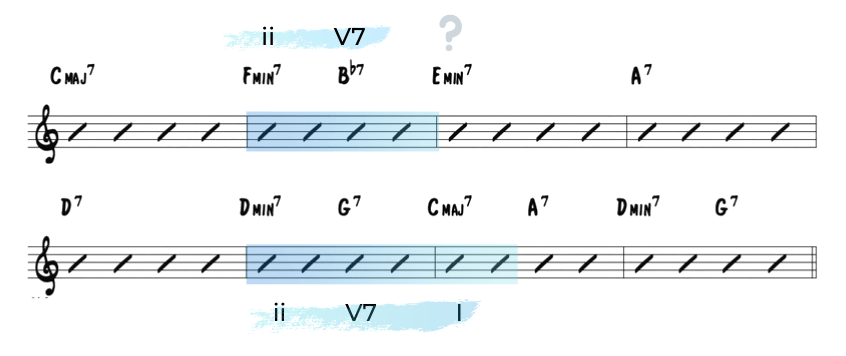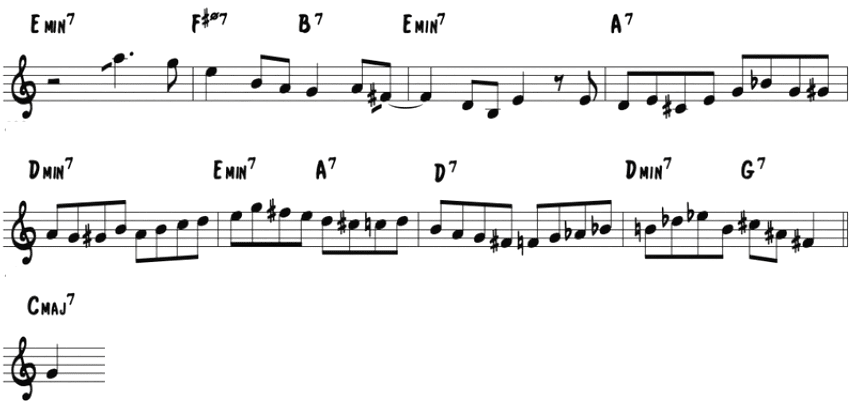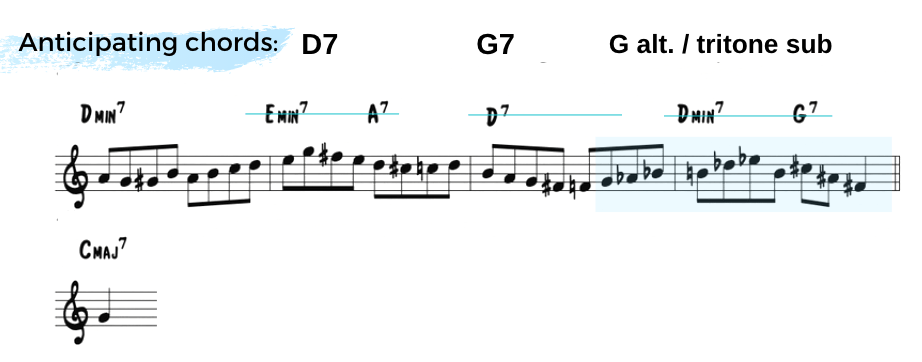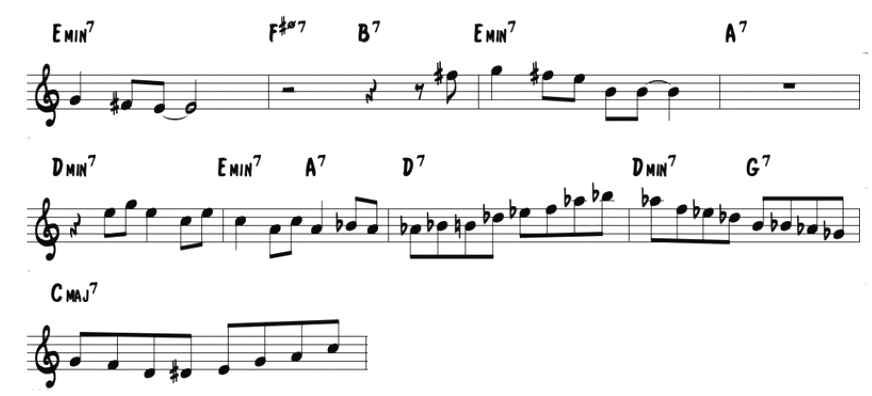One thing that often gets lost in the music theory and technical exercises of our daily practice is the fact that improvisation at it’s core, is musical storytelling…
Think about it, any tune that you play or any solo that you take is a platform for you to tell your own story…an opportunity to share all of the things that you’ve learned, that you’re hearing, and that you’re feeling in the moment.
And the success of your solo comes down to how well you craft this story – how you develop your ideas, the style in which you play them, and how your phrases flow seamlessly from one to the next.
Every great player that we love to listen to is a masterful storyteller with the elements of sound, and one of the best musical storytellers you can find is Roy Hargrove.
In the lesson below we’ll take an in-depth look at 5 phrases that Roy plays over a classic jazz standard and study the exact techniques he uses to create long musical phrases that tell a story…
The tune: Yardbird Suite
The five phrases we’ll check out today come from Roy’s solo on the tune Yardbird Suite from the Roy Haynes album Birds of a Feather.
“Bird is essential. The fabric of this music deals with harmonic integrity. Trying to be an improviser without knowing Bird is like writing a novel with no vocabulary.” ~ Roy Hargrove
Roy takes the first solo at [0:50] in the recording below:
Before we jump into some specific phrases of the solo however, let’s take a look at the chord progression to this Charlie Parker standard…
As you can see, the harmonic movement in this tune is similar to dozens of other jazz standards that you’ll frequently encounter. The big question that you need to answer as a soloist is…How do I tell a musical story over this progression??
One the keys to playing effortlessly and musically over any jazz standard is getting beyond the theory of individual chords and scales and thinking in terms of larger musical phrases.
And this is not exactly easy to do, but there are a few steps that will put you in the right direction…
3 steps to creating phrases
Before you dive in and start trying to create phrases like your favorite players, there are some prerequisite steps to take that will make things a lot easier.
You see, the term “phrasing” is often thrown around when it comes to improvisation, but many musicians don’t know exactly what this means…and as a result we end up trying to wing it with chords and scales.
Phrasing isn’t something that happens automatically if you learn your scales, memorize chords, and endlessly run through tunes. It’s a skill that involves your ears, language, and a deep understanding of harmony.
The truth is, phrasing is not just a melodic exercise or the result of all the licks you’ve memorized – it’s directly tied to how you conceptualize & hear the harmony of any tune.
And there are three steps that will eventually lead you to playing longer musical phrases and understanding the phrases in the great solos you study. I’ll show you what I mean…
Step 1 – A melodic approach to individual sounds
When we start out with improvisation and dealing with the harmony of tunes, we are focused on individual chords and finding the “right notes” to play:
This isn’t exactly musical phrasing, but it’s an essential step in the right direction because the seed of a musical idea starts with one sound. If you can’t create melody over one chord, how can you make a phrase over multiple chords??
In order to do this you need to be able to hear chord quality, specific chord tones, and have language for each type of chord.
But keep in mind that this is only the first step. Creating longer phrases will continue to be difficult if you’re always stuck thinking about one chord at a time….
Step 2 – Identify common progressions
As we progress, we start working on connecting these individual chords and sounds, navigating through common harmonic progressions that recur in the repertoire.
We learn about and practice harmonic relationships like I to IV and V7 to I, cycle movement, and the ii-V-I progression.
And when we pick out a tune to play we look for these individual progressions or chord relationships that we know and apply techniques to navigate them:
These are small pieces of the puzzle that we need to know, but we’re still not integrating them into the larger progression or creating longer musical phrases…
Step 3 – Understand the function of the harmony and create phrases
The third piece of the puzzle is understanding the function of Major harmony and minor harmony and how these are used in the jazz repertoire.
You need to understand how the larger progression of a tune relates to a key and how each chord functions in the harmony. This is the key to creating and connecting longer musical phrases over the entire form of the tune.
If we go back to the ‘A’ section of Yardbird Suite, you can see that the harmonic movement is based on the tonic key of C…an 8 bar sequence all related to one key:
You start and end in the key of C Major and each progression in between is related in some way to this home key.
What’s more these chords logically resolve one to the next: E- to A7 to D7 to D- to G7, all resolving to C. You find ii-V’s, turnarounds, and cycle movement all in the universe of C Major.
Ideally, this is how you want to be approaching any tune that you play – it’s the stage where longer phrasing becomes possible and where you can really start to develop your musical story.
And this is when transcribing and studying the phrases of master musicians will make a lot more sense! With this in mind, let’s take a look at how Roy Hargrove creates phrases and connects them on Yardbird Suite…
Roy Hargrove: 5 Phrases
There is a lot of valuable language in this solo that you can learn and apply to any standard…
And this is something you should spend time learning from this solo. But, today we’re going to look at the bigger picture and focus specifically on how Roy crafts his phrases.
Along with studying his 8 bar phrases that seamlessly navigate the harmony, it’s also useful to look at how he moves between them and transitions to new sections in his solo.
Part of storytelling is creating interest – tension and resolution – and Roy does this in a few ways…
1) Creating tension & transitions in the ‘A’ section:
On the ‘A’ section he either creates tension within the phrase before resolving to the I chord or at the end leading to the Bridge or another ‘A’:
Resolving within the phrase and resolving to the upcoming phrase.
2) Creating tension & transitions on the Bridge:
On the Bridge, he approaches the 8 bar section as one unit, creating harmonic tension at the end of the phrase that will resolve back to the a section:
Let’s take a closer look at how he implements these techniques within his 8 bar phrases…
Phrase #1 >> ‘A’ Section
The first phrase we’ll look at happens in his first chorus on the 2nd A that leads to the Bridge:
As you can hear, Roy creates a forward moving phrase from C Major to CMajor, with each chord resolving or moving forward seamlessly to the next.
Notice how he utilizes enclosure to move from the I to the backdoor to the iii and the to the IV chord:
He also introduces harmonic tension at end of phrase, emphasizing the F# (#11) on C Major, ending the ‘A’ section and leading to the Bridge.
This lydian sound, played in a B minor pentatonic shape, catches your ear and anticipates upcoming harmony of the Bridge, E minor.
Phrase #2 >> Bridge
Now let’s take a listen to what Roy plays on the Bridge of his first chorus, the next 8 bars:
Here he approaches the i – ii V- i progression as simple melodic statement in E minor, without having to outline every chord. The A7 chord then serves as a V7 moving to D minor:
However in the next four bars he anticipates the arrival of chords the (D7) and (G7) by one measure:
He also introduces harmonic tension in the last bar and a half of the phrase, altering the G7 and resolving back to the C Maj of the ‘A’ section.
Phrase #3 >> ‘A’ Section
This phrase comes from the ‘A’ section at the beginning of his second chorus on the tune:
Roy uses similar techniques here to his previous phrases and ends with a turnaround line that leads back to the top of the second ‘A.’ Turnarounds are a good place to add harmonic alterations before resolving back to the tonic.
In this spot Roy highlights the tritone (b5) on the V7 chords:
This hints at the tritone sub of the V7 chords:
Because turnarounds pop up all the time in the standard repertoire, this line would be a useful one to learn in all keys and implement in your solos!
Phrase #4 >> ‘A’ Section
Here is the second ‘A’ section of Roy’s 2nd chorus:
In this phrase notice how he starts his line in the second bar, playing C major language over the (F- Bb7). Because he is creating his ideas around the larger direction of the harmony and longer phrases he doesn’t have to be tied to individual chords.
He finishes the phrase by utilizing tritone subs (Db over G7) to create harmonic tension on V7 chord before resolving:
Phrase #5 >> Bridge
Finally, let’s take a look at what Roy plays on the Bridge of his second chorus…
He begins with a simple idea in E minor, then an arpeggiated shape over D minor, simplifying the harmonic approach to the first 6 bars.
The line leads into harmonic tension over the D7 and D- G7 chords…
Here he uses a similar line to the last phrase, utilizing a G7 altered sound that resolves to the C Major chord in the following bar.
Build Your Own Phrases
Being able to hear and play longer phrases over the form of a tune is something that takes time and practice…
However, this Roy Hargrove solo is the perfect blueprint to follow no matter which level you may find yourself at.
Along with the five phrases we highlighted above, there are great examples of each of the 3 phrasing steps you can isolate and take directly from this solo, specifically:
- Major, V7, and minor language
- Backdoor ii-V’s
- Turnarounds
- ii-V’s
- Dominant alterations
To start, aim to develop language over the basic chord types (Major, minor, V7, and half-diminshed). If you’re looking for more instruction, check out our course Melodic Power, which covers each of these in detail.
Next, practice applying this language and technique to common chord relationships. Along the way review the function of Major and minor harmony and how this relates to jazz standards.
Finally, study and transcribe musical phrases from your favorite players and study the techniques they are using to play longer lines and navigate the form.
Remember, no matter which stage you’re at in your development, the secrets to each of these steps can be found in this solo. Go slowly and take your time, and listen to the musical story he’s telling you through the progression!
































